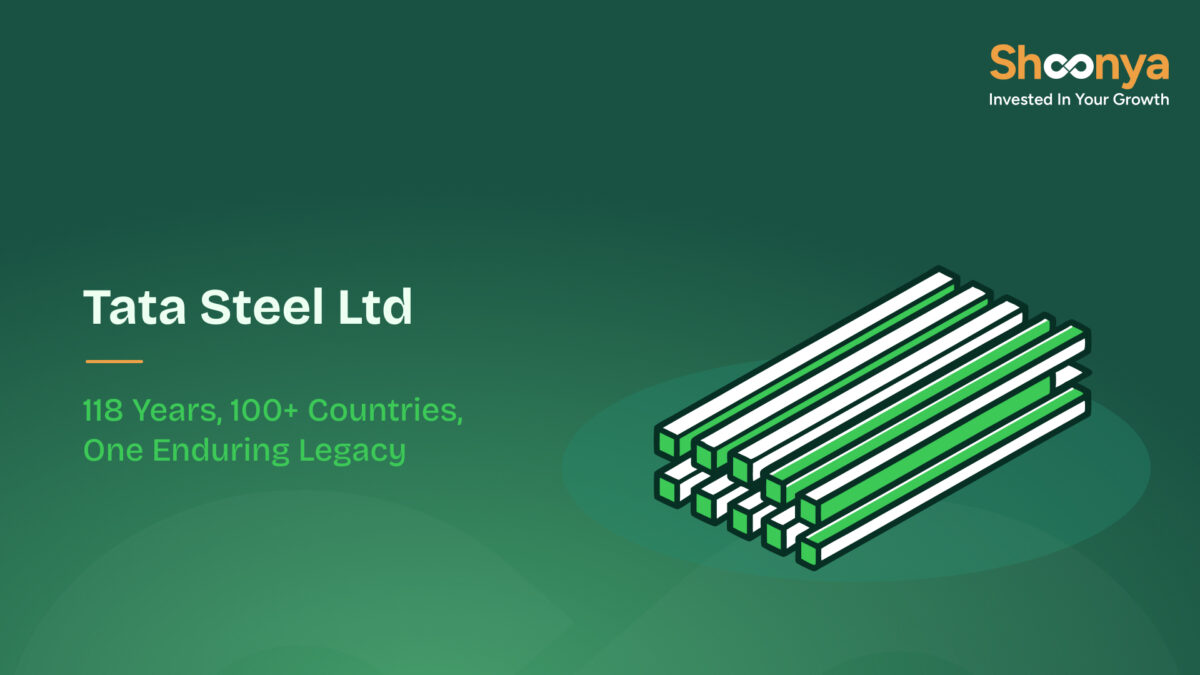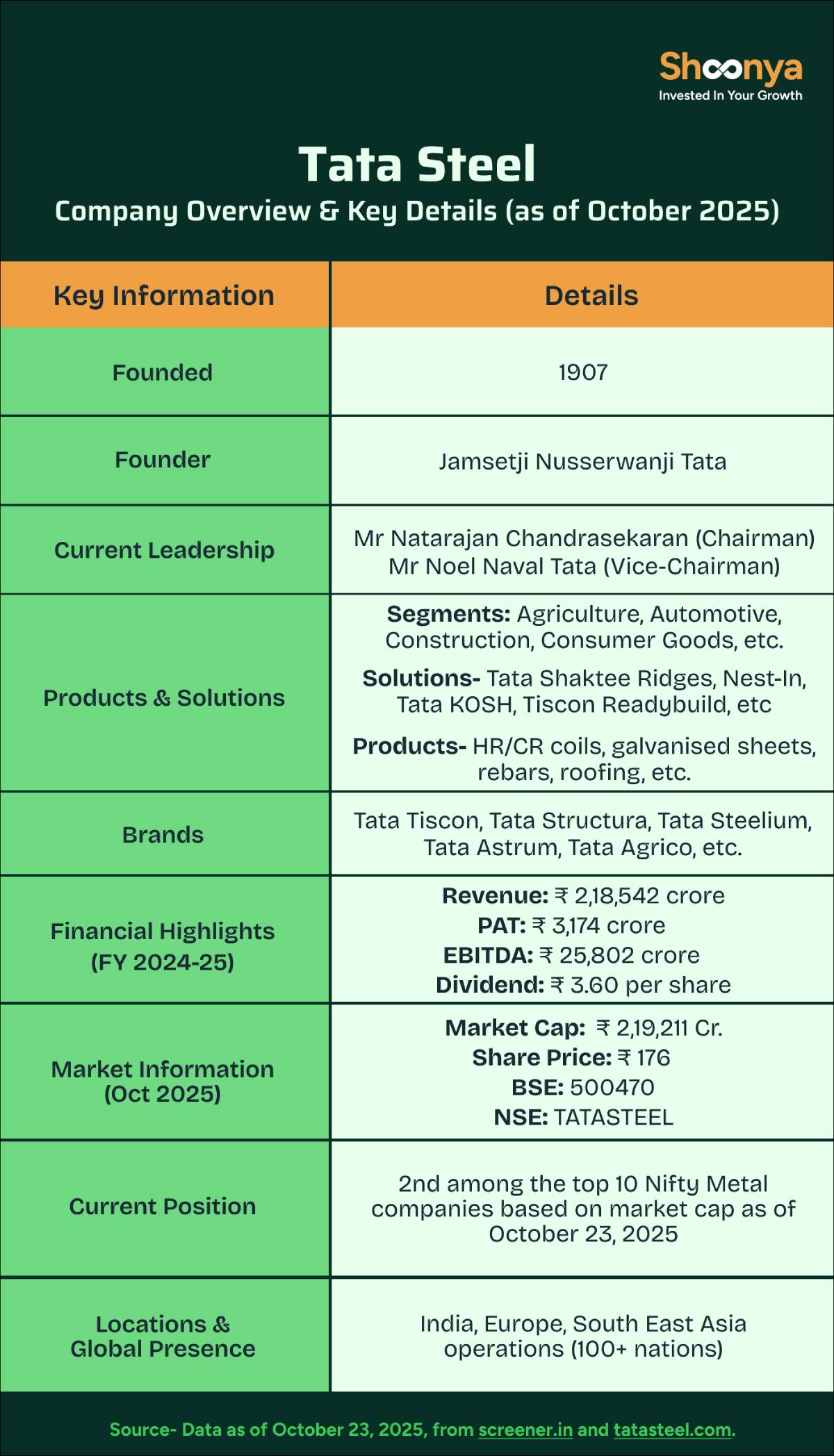History of Tata Steel Ltd: Share Price, Financials, Ownership, and Milestones

When we talk about India’s development, we start with the bridges we cross, the buildings we work in, and the roads we travel. Every bridge that is built across a river, every high-rise that shapes a skyline, every industrial facility that drives local jobs, Tata Steel has played a role in all of it. For over 118 years, the Tata Group has been the source of strength and reliability behind the nation’s infrastructure and industrial growth.
Founded in 1907, Tata Steel today serves 100+ countries.
Let us read about the history of Tata Steel Limited today.

Tata Steel History – How Did It All Begin
Founded in 1907 as TISCO in Jamshedpur, Tata Steel was India’s first integrated steel plant. It expanded globally through the acquisition of NatSteel in 2004 and Corus in 2007. The Kalinganagar plant commenced operations in 2016.
Tata Steel’s story is not just about steel. It is about how an Indian dream took shape in fire and iron, and then grew into a force that reshaped how a country built itself.
From the first furnace in Jamshedpur to digital plants and decarbonisation goals, every milestone carries the reinvention and responsibility.
The Early Foundations (1882–1918)
It began in 1882, when Jamsetji Tata’s fascination with iron ore deposits in central India lit the spark for what would become Asia’s first integrated private steel plant. The Swadeshi movement was gaining strength, and the idea of building Indian industry with Indian hands was a national calling.
In 1907, Tata Iron and Steel Company was born — under Sir Dorabji Tata’s watch, the dream that Jamsetji had nurtured for decades finally stood on solid ground at Sakchi, later called Jamshedpur.
By 1911, the first blast furnace came alive. A year later, the first steel ingot rolled out. The same year, the company introduced the eight-hour working day for its workforce.
By 1918, Tata Steel had commissioned India’s first coke plant.
The Interwar Growth (1919–1939)
The years that followed were marked by scale, learning, and scientific curiosity. In 1920, the company set up The Tinplate Company of India. By 1937, a Research & Control building stood tall at Jamshedpur — one of the earliest industrial R&D setups in India.
By 1939, as the world went to war, Jamshedpur had become the largest steel plant in the British Empire.
The Post-War Modernisation (1940s–1970s)
After independence, the focus shifted from survival to scale. The 1950s saw Tata Steel sign a landmark agreement with Kaiser Engineers to raise capacity to two million tonnes. The company was modernising, expanding, and setting new benchmarks in productivity and quality.
Through the 1960s and 1970s, the R&D divisions pushed into process technologies, raw-material optimisation, and continuous improvements.
Seeds of Globalisation (1980–2005)
By the 1980s, Tata Steel’s modernisation phases were in full swing. Technology absorption, R&D-driven process control, and coal-blend optimisation defined the era. The company had learned to evolve with the times without losing its cultural centre.
In 1990, it opened a subsidiary in New York.
Then came a turning point: in 2004, Tata Steel acquired NatSteel in Singapore.
A year later, the name TISCO gave way to Tata Steel Limited.
The Global Leap and the Centenary (2006–2012)
In 2007, Tata Steel acquired Corus Group in the UK and the Netherlands, instantly becoming one of the world’s largest steel producers.
The following year, as the company marked its centenary, India’s Prime Minister released a commemorative postage stamp.
In 2012, Tata Steel became the world’s first integrated steel company to receive the Deming Grand Prize for quality.
Reshaping and Expanding (2013–2019)
This was a decade of scale. In 2016, Tata Steel inaugurated its second integrated plant at Kalinganagar.
By 2018, it had acquired Bhushan Steel, now Tata Steel BSL, expanding its flat products and automotive-grade capabilities. The following year, the company began Phase II expansion at Kalinganagar and acquired the steel business of Usha Martin.
Technology, Sustainability, and Leadership (2020–2024)
As the 2020s began, the narrative shifted from expansion to transformation. Tata Steel embraced digitalisation, sustainability, and cost leadership as its core drivers.
By 2023–24, Tata Steel India recorded its highest-ever crude steel production of 20.8 million tonnes, backed by strong R&D investment, community reach, and sustainability goals.
In 2024, the company doubled down on its decarbonisation journey, advanced product mix, and deeper European restructuring.
The 2025 Vision and Forward Path
As of 2025, Tata Steel’s Kalinganagar expansion is underway to raise capacity from 3 to 8 million tonnes per annum.
The European operations continue their transformation under a unified sustainability and profitability framework, while India remains the anchor of growth.
Quick Glance: Key Milestones of Tata Steel Limited
| Year | Milestone |
| 1907 | TISCO incorporated – Asia’s first integrated private steel company |
| 1911 | First blast furnace operations begin at Jamshedpur |
| 1912 | First steel ingot rolled; 8-hour working day introduced |
| 1918 | India’s first Coke plant was commissioned |
| 1937 | Research & Control building established |
| 1955 | Kaiser Engineers pact for 2 MTPA expansion |
| 2004 | NatSteel (Singapore) acquired |
| 2005 | Renamed Tata Steel Limited |
| 2007 | Corus Group acquired (UK–Netherlands) |
| 2012 | Deming Grand Prize awarded |
| 2016 | Kalinganagar plant starts production |
| 2018 | Bhushan Steel acquired (Tata Steel BSL) |
| 2019 | Kalinganagar Phase II expansion announced |
| 2024 | Highest-ever India production, 20.8 MTPA |
| 2025 | Kalinganagar ramp-up to 8 MTPA; focus on advanced steels |
What Does Tata Steel Do
Tata Steel is one of the leading steel manufacturing companies in India.
It is a worldwide steel manufacturer involved in every stage of steel production, from sourcing raw materials to producing and selling a diverse range of steel products. The company operates across five continents and serves industries including automotive, construction, and engineering. As of October 23, 2025, it is the second-largest company in the Nifty Metal Index based on market capitalisation.
Established in 1907, it remains one of the world’s most geographically diversified and technologically advanced steel producers.
With an annual crude steel capacity exceeding 35 million tonnes per annum (MTPA) and an employee base of about 78,000, Tata Steel represents not only industrial might but also continuity.
Tata Steel Products and Market Segments
Tata Steel’s Indian business is structured across four major divisions:
- Automotive & Special Products – supplying advanced, high-strength steels to carmakers and specialised engineering applications.
- Industrial Products, Projects & Exports – serving construction, energy, and heavy engineering markets.
- Branded Products & Retail – offering well-known consumer-facing brands such as Tata Tiscon, Tata Structura, Tata Steelium, and Tata Agrico.
- Services & Solutions – providing integrated design, fabrication, and steel application support.
Tata Steel Financial Results Q1 2025
Strong performance: Consolidated revenues stood at ₹53,178 crore
India operations: Reported revenues of ₹31,137 crore and EBITDA of ₹7,486 crore (24% margin).
Europe operations: The UK reported revenues of £536 million with a reduced EBITDA loss of £41 million, while the Netherlands achieved revenues of €1,519 million.
Tata Steel Share Price and Company Overview: Key Facts Every Investor Should Know
Tata Steel is a core company within the Tata Group, one of India’s most respected conglomerates.
Tata Steel Shares:
Tata Steel shares trade actively on both NSE (TATASTEEL) and BSE (500470).
Tata Steel Share Price Today:
The live price of Tata Steel is available on the BSE under 500470 and the NSE under the symbol TATASTEEL. As of Oct 23rd, 2025, the Tata Steel Share Price is ₹ 175.
Invest Smartly in Tata Steel Shares Today- Start your journey with a free demat account and access advanced tools, live price analysis, technical indicators, and more.
Tata Steel Share Rate:
The term “share rate” refers to the current trading price of Tata Steel stock. As of 23 October 2025, Tata Steel Ltd’s share price is ₹175.
Tata Steel Owner:
Tata Steel is promoted by the Tata group. N. Chandrasekaran serves as Chairman of the Board, while T. V. Narendran is the Global CEO and Managing Director.
Tata Steel Net Worth:
In market terms, “net worth” usually refers to market capitalisation, which currently stands at around ₹ 2,18,524 Cr.
Tata Steel Revenue:
For FY24, Tata Steel reported consolidated revenue of ₹2,29,171 crore as per its Integrated Report.
Tata Steel Shares List:
The company’s primary equity shares are listed on NSE (TATASTEEL) and BSE (500470).
Tata Steel’s Sustainability Strategy
Tata Steel is driving a large-scale sustainability transformation across India and Europe.
- Net-zero roadmap: The company aims for net-zero Scope 1 and 2 emissions by 2045, with milestones like a 30% CO₂ cut by 2030 in the UK and region-specific decarbonisation roadmaps.
- Circular steelmaking: The expansion of scrap-based recycling, including the Ludhiana plant, which is due by FY25, supports a circular economy and future low-carbon growth in India.
- Green logistics: Transition to biofuel and LNG vessels, rail freight, and renewable-powered transport is reducing logistics emissions across global operations.
- Global recognition: Named a Steel Sustainability Champion for eight consecutive years, Tata Steel continues transparent climate reporting and strong governance to sustain progress.
From worker safety and skill development to healthcare and education in its industrial townships, Tata Steel continues to uphold its founding belief that the community is not just a stakeholder. It is the very purpose of business.
Conclusion
The company’s story began in 1907 with a single furnace in Jamshedpur. Over a century later, it operates across continents, driven by the same vision: to make the Indian industry globally competitive and socially responsible.
From acquiring NatSteel in Singapore (2004) to Corus in the UK and the Netherlands (2007), Tata Steel has grown beyond geography while holding firmly to its identity.
Today, Tata Steel stands as a rare industrial organisation that blends heritage and innovation, scale and conscience, engineering and empathy.
More than a century after its birth, Tata Steel remains anchored in one belief — that industry must exist not only to create products, but to create progress.
Tata Steel Limited- FAQs
Tata Steel Limited is a leading global steel manufacturer and a key company within the Tata Group. It handles the complete steel value chain from mining raw materials to producing and marketing finished steel products.
No, Tata Steel Limited is not a government-owned company. As of September 30, 2023, Tata Sons Private Limited holds 32.44% of the company, while the rest is held by public shareholders and institutions, reflecting its status as a publicly listed, privately controlled entity.
The seven major entities are Tata Steel India, Tata Steel Europe, Tata Steel Netherlands, Tata Steel Thailand, Tata Steel Downstream Products Ltd., TRF Limited, and The Tinplate Company of India Ltd.
Founded in 1868 by Jamsetji Tata, the Tata Group is India’s largest conglomerate with 29 publicly listed companies across steel, automotive, IT, consumer goods, energy, finance, and hospitality.
Tata Steel’s main products include hot-rolled steel, cold-rolled steel, coated coils, tubes, rebars, and wire rods for automotive, infrastructure, construction, and engineering sectors.
India’s number one steel plant is the JSW Steel plant in Vijayanagar, Karnataka. It is the largest single-location steel-producing facility in the country, with a capacity of 17.5 MTPA.
Source: Screener.in
Disclaimer: Investments in the securities market are subject to market risks; read all the related documents carefully before investing.








